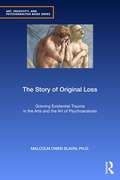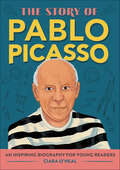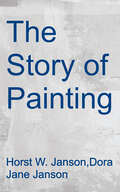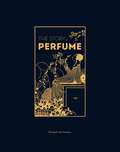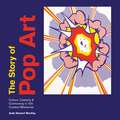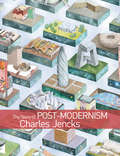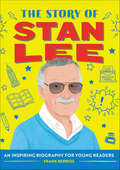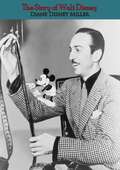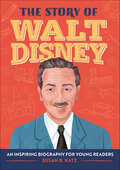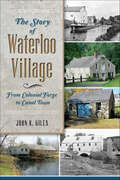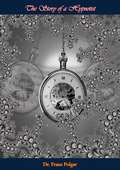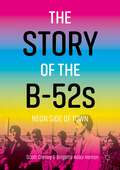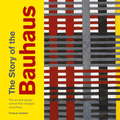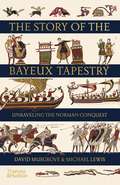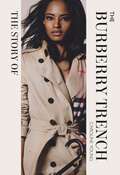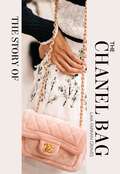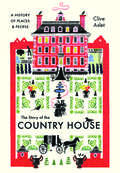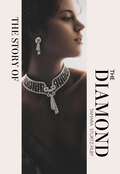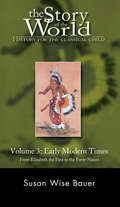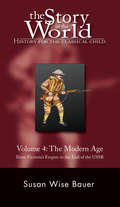- Table View
- List View
The Story of Original Loss: Grieving Existential Trauma in the Arts and the Art of Psychoanalysis (Art, Creativity, and Psychoanalysis Book Series)
by Malcolm Owen Slavin, PhDThis book explores the universal human existential trauma of "original loss," a trauma the author describes as arising from our primal, human evolutionary loss of experiencing ourselves as innately belonging to, and instinctively at home within, the larger natural world.In this trauma arose our existential awareness of impermanence and mortality along with the need to mourn that loss in order to create a sense of belonging and identity. The book describes how the invention of art and group ritual became the collective ways we mourn our shared existential loss. It describes as well how it is the art within the psychoanalytic practice that enables both patient and analyst to grieve their individual versions of our shared original loss. Drawing on the work of Winnicott, Loewald and Ogden, as well as art theory and religion, this book offers a new perspective on the intersection of metaphorical artistic thinking and psychoanalysis.This book will appeal to psychoanalysts, psychotherapists, and scholars of poetic, visual and muscial metaphor, creativity, evolution and history of art.
The Story of Pablo Picasso: An Inspiring Biography for Young Readers (The Story of Biographies)
by Ciara O'NealDiscover the life of Pablo Picasso—a story about endless imagination and creativity for kids ages 6 to 9Pablo Picasso was a famous artist who loved to break the rules and try out new ideas. Before he transformed what people thought about art, he was a young boy who loved to draw and observe the world around him. He mastered classical art styles and then invented new ways of expressing his creativity. This book explores how Picasso went from being a talented boy growing up in Spain to a respected artist who changed the world.Independent reading—This Picasso biography is broken down into short chapters and simple language so kids 6 to 9 can read and learn on their own.Critical thinking—Kids will learn the Who, What, Where, When, Why, and How of Picasso's life, find definitions of new words, discussion questions, and more.A lasting legacy—Find out how Picasso changed the art world and inspired countless others to express themselves through creativity.How will Picasso's imagination and originality inspire you?Discover activists, artists, athletes, and more from across history with the rest of the Story Of series, including famous figures like: Frida Kahlo, Ella Fitzgerald, Maya Angelou, Audrey Hepburn, and Leonardo da Vinci.
The Story of Painting: From Cave Painting to Modern Times
by Outlet Book Company Staff Random House Value Publishing StaffHere is a volume as rare as it is beautiful. It is a picture gallery, with more - and larger - color plates than have ever before appeared in a book of this sort; and at the same time, it is a remarkable and even exciting story of how painting began and how it developed through the ages.
The Story of Perfume: A lavishly illustrated guide
by Elisabeth de FeydeauWhat parts of the world do fragrances come from? Who invented them and what are their main ingredients? How did perfume cross from the sacred to the profane? Who were the first great perfumers? What role has the fashion industry played in the history of perfume? How do you become a successful 'nose'? What stories lie behind iconic perfumes such as Chanel's N°5, CK One, of Jean Paul Gaultier's Le Mâle? Lavishly illustrated with archival documents from the most beautiful fragrance brands, The Story of Perfume transports its readers into a precious and mesmerizing world.
The Story of Perfume: A lavishly illustrated guide
by Elisabeth de FeydeauWhat parts of the world do fragrances come from? Who invented them and what are their main ingredients? How did perfume cross from the sacred to the profane? Who were the first great perfumers? What role has the fashion industry played in the history of perfume? How do you become a successful 'nose'? What stories lie behind iconic perfumes such as Chanel's N°5, CK One, of Jean Paul Gaultier's Le Mâle? Lavishly illustrated with archival documents from the most beautiful fragrance brands, The Story of Perfume transports its readers into a precious and mesmerizing world.
The Story of Pop Art (The Story of ...)
by Andy Stewart MacKayIn this age of insta-stardom and selfies, Pop Art still defines the world we live in.Emerging in the 1950s, Pop Art arrived in an explosion of colour, offering bold representations and plenty of humour. All of the celebrities, events and politics that came to define two turbulent decades are encapsulated in their work. Pop Art challenged the establishment and offered a new modernism, blurring the line between art and mass production.Uncover 100 stories in this essential guide to a groundbreaking movement. Enjoy enlightening critiques of iconic works; meet key figures including Warhol and Hockney; and discover inspirational ideas and novel new methods.
The Story of Post-Modernism
by Charles JencksIn The Story of Post-Modernism, Charles Jencks, the authority on Post-Modern architecture and culture, provides the defining account of Post-Modern architecture from its earliest roots in the early 60s to the present day. By breaking the narrative into seven distinct chapters, which are both chronological and overlapping, Jencks charts the ebb and flow of the movement, the peaks and troughs of different ideas and themes. The book is highly visual. As well as providing a chronological account of the movement, each chapter also has a special feature on the major works of a given period.The first up-to-date narrative of Post-Modern Architecture - other major books on the subject were written 20 years ago.An accessible narrative that will appeal to students who are new to the subject, as well as those who can remember its heyday in the 70s and 80s.
The Story of Stan Lee: An Inspiring Biography for Young Readers (The Story Of)
by Frank BerriosDiscover the life of Stan Lee—a story about creating your own adventures for kids ages 6 to 9Stan Lee was a famous comic book writer, artist, editor, and publisher for Marvel Comics. Before he helped create heroes like the Incredible Hulk, Spider-Man, the X-Men, and Black Panther, Stan was an imaginative boy who spent hours reading all sorts of different stories and letting his thoughts run wild. These stories inspired him to come up with exciting plots and new characters of his own.Independent reading—This Stan Lee biography is broken down into short chapters and simple language so kids 6 to 9 can read and learn on their own.Critical thinking—Kids will learn the Who, What, Where, When, Why, and How of Stan's life, find definitions of new words, discussion questions, and more.A lasting legacy— Explore how Stan went from being a young boy growing up in New York City to a comic book legend.How will Stan's colorful imagination and hard work inspire you?Discover activists, artists, athletes, and more from all across history with the rest of The Story Of series, including famous figures like: Albert Einstein, Amelia Earhart, Jim Henson, Fred Rogers, and Frida Kahlo.
The Story of Walt Disney
by Diane Disney MillerWritten by Diane Disney Miller, Walt Disney’s eldest daughter, The Story of Walt Disney offers an intimate and heartfelt portrait of the man who created one of the most beloved entertainment empires in history. This book provides a unique perspective on Walt Disney, not just as the visionary behind iconic films, theme parks, and characters, but also as a devoted father, husband, and dreamer.Through Diane’s personal anecdotes and insights, readers are taken on a journey through Walt Disney’s life—from his humble beginnings in rural Missouri to his rise as a creative powerhouse. The book chronicles his early struggles, his unrelenting drive to innovate, and the moments of triumph that cemented his legacy as a pioneer of animation and storytelling.Interwoven with behind-the-scenes stories about Disney’s groundbreaking work, the book also delves into his personal life, offering a rare glimpse of the man behind the magic. Diane’s perspective adds warmth and authenticity, showcasing Walt’s love for his family, his passion for creativity, and his determination to bring joy and inspiration to people around the world.Rich with photographs and heartfelt recollections, The Story of Walt Disney is a touching tribute to a man whose imagination and perseverance left an indelible mark on the world. Perfect for Disney fans, historians, and anyone curious about the life of this cultural icon, this book celebrates the remarkable legacy of a dreamer who dared to believe in the impossible.
The Story of Walt Disney: An Inspiring Biography for Young Readers (The Story of Biographies)
by Susan B. KatzDiscover the life of Walt Disney—a story about imagination and invention for kids ages 6 to 9Walt Disney was a talented artist who created magical new worlds in the form of TV shows, movies, and amusement parks. Before he won the hearts of millions with characters like Mickey Mouse and Donald Duck, Walt was an imaginative boy who loved drawing. He learned how to use the newest technology to make cartoons that would entertain and delight viewers all over the world. This essential Disney story explores how Walt went from being a young boy growing up in the Midwest to being a creative genius.Independent reading—This Walt Disney biography book is broken down into short chapters and simple language so kids 6 to 9 can read and learn on their own.Critical thinking—With this Walt Disney chapter book, kids will learn the Who, What, Where, When, Why, and How of Walt's life, find definitions of new words, discussion questions, and more.A lasting legacy—Kids will discover some of the history of Walt Disney World and Disneyland, and how Walt changed the world of animation and entertainment for future generations.How will Walt's hard work and love of storytelling inspire you?Discover activists, artists, athletes, and more from across history with the rest of the Story Of series, including famous figures like: Fred Rogers, Jim Henson, Stan Lee, Lin-Manuel Miranda, and Audrey Hepburn.
The Story of Waterloo Village: From Colonial Forge to Canal Town (Landmarks)
by John R. GilesFirst established in the 1700s as a forge village, Waterloo--located in Sussex County, New Jersey--has endured several eras of decline and growth. An industrial hub and farming community, it played a role in the American Revolution. When the canal arrived, Waterloo reinvented itself into a vital transportation link that helped foster the new nation's first Industrial Revolution. The peacefulness of the canal belies the complex engineering required to integrate it into the village's footprint. Today, beautifully preserved colonial-era buildings complement pre-Civil War structures, Victorian mansions and twentieth-century edifices. Local author John Giles illuminates the constant ebb and flow of the history of Waterloo Village.
The Story of a Hypnotist
by Kurt Singer Dr Franz Polgar"Dr. Franz Polgar (April 18, 1900 - June 1979) was a renowned psychologist, hypnotist, lecturer and entertainer. Born in city of Enying, Hungary, he earned a PhD in Psychology from the University of Budapest. In his 1951 autobiography Polgar claimed that he had served as Sigmund Freud's "medical hypnotist" (Polgar's term) in 1924 and had worked in close association with Freud for six months and had assisted in the treatment of Freud's patients. He immigrated to the United States in 1935 and honed his hypnotism skills by working in speakeasy bars in New York City. He married his wife, Lillian, in 1938 and she became his booking and publications manager. They had two children, Julian and Risa."
The Story of the B-52s: Neon Side of Town
by Scott Creney Brigette Adair HerronThe Story of the B-52s: Neon Side of Town is the first critical history of one of the most legendary and influential bands in American popular music. Locating The B-52s in the intellectual climate of their hometown of Athens, GA and following the band from New York’s downtown scene in the early 1980s to their upcoming farewell tour, the book argues that The B-52s are much more significant political and musical influences on American society than their reputation as a silly party band suggests, and that their ongoing commitment to values including cooperation, mutual support, and using disruptive fun as a form of social change are an antidote to the neoliberalization sweeping both Athens and the rest of the Western world. For example, the book shows how the band synthesized influences from the modern artists displayed at the University of Georgia art museum, early queer activism on campus in the 1970s, and their experiences as queer people living through the AIDS crisis to create music that continues to be artistically and politically influential today. The authors are active members of the Athens, GA music scene, and the book includes original interviews with a range of number close to the band.
The Story of the Bauhaus (The Story of ...)
by Frances AmblerNow 100 years old, the Bauhaus still looks just as fresh today as it did when it began. It was a place to experiment and embrace a new creative freedom. Thanks to this philosophy, the Bauhaus still shapes the world around us. Trace The Story of the Bauhaus through the 100 personalities, designs, ideas and events that shaped this monumental movement. Learn about leaders Paul Klee, Walter Gropius, Anni Albers and Wassily Kandinsky; witness groundbreaking events and wild parties that would revolutionise contemporary design; and discover a range of innovative ideas and new ways of thinking.
The Story of the Bauhaus (The\story Of ... Ser.)
by Frances AmblerNow 100 years old, the Bauhaus still looks just as fresh today as it did when it began. It was a place to experiment and embrace a new creative freedom. Thanks to this philosophy, the Bauhaus still shapes the world around us. Trace The Story of the Bauhaus through the 100 personalities, designs, ideas and events that shaped this monumental movement. Learn about leaders Paul Klee, Walter Gropius, Anni Albers and Wassily Kandinsky; witness groundbreaking events and wild parties that would revolutionise contemporary design; and discover a range of innovative ideas and new ways of thinking.
The Story of the Bayeux Tapestry: Unraveling The Norman Conquest
by Michael Lewis David MusgroveThe definitive and fully illustrated guide to the Bayeux Tapestry. The full history of the events leading up to the Battle of Hastings and the story of the tapestry itself. Most people know that the Bayeux Tapestry depicts the moment when the last Anglo-Saxon king of England, Harold Godwinson, was defeated at the Battle of Hastings in 1066 by his Norman adversary William the Conqueror. However, there is much more to this historic treasure than merely illustrating the outcome of this famous battle. Full of intrigue and violence, the tapestry depicts everything from eleventh-century political and social life—including the political machinations on both sides of the English Channel in the years leading up to the Norman Conquest—to the clash of swords and stamp of hooves on the battle field. Drawing on the latest historical and scientific research, authors David Musgrove and Michael Lewis have written the definitive book on the Bayeux Tapestry, taking readers through its narrative, detailing the life of the tapestry in the centuries that followed its creation, explaining how it got its name, and even offering a new possibility that neither Harold nor William were the true intended king of England. Featuring stunning, full- color photographs throughout, The Story of the Bayeux Tapestry explores the complete tale behind this medieval treasure that continues to amaze nearly one thousand years after its creation.
The Story of the Burberry Trench
by Caroline YoungThe epitome of British heritage fashion, the Burberry trench coat is a beloved wardrobe classic. Practical yet versatile; it is sleek and sexy but also a preppy favourite. Since the launch of the coat in 1912, Burberry has unveiled a selection of styles that has reached iconic stature – and here you will discover their original designs, seasonal adaptations and limited editions.The book also takes a behind-the-scenes look at the craftsmanship, the preloved market and how to authenticate a Burberry. So, whether you are considering buying retail or secondhand, dressing for weather or fashion, this is your ultimate guide to the world's most famous coat.
The Story of the Burberry Trench
by Caroline YoungThe epitome of British heritage fashion, the Burberry trench coat is a beloved wardrobe classic. Practical yet versatile; it is sleek and sexy but also a preppy favourite. Since the launch of the coat in 1912, Burberry has unveiled a selection of styles that has reached iconic stature – and here you will discover their original designs, seasonal adaptations and limited editions.The book also takes a behind-the-scenes look at the craftsmanship, the preloved market and how to authenticate a Burberry. So, whether you are considering buying retail or secondhand, dressing for weather or fashion, this is your ultimate guide to the world's most famous coat.
The Story of the Chanel Bag: Timeless. Elegant. Iconic.
by Laia Farran GravesTimeless and ever-fashionable, the Chanel handbag is the luxury goods statement piece that is always in demand. Since the launch of the 2.55 in 1955, Chanel has unveiled a curated classic selection of styles that has reached iconic stature – and here you will discover their myriad seasonal adaptations, limited editions and special features.From the ultra-rare beaded lucite Cage Flap to the discontinued Diana (named after Princess Di), the So Black to the Graffiti backpack, the book traces the rise of the Chanel bag from the very first designs to today's releases and charts the Chanel bag in popular culture and celebrity fashion.A detailed behind-the-scenes look at the craftsmanship explains the details of quilting, leathers and materials, hardware, labels and stitching, as well as how to authenticate a Chanel bag. Whether you are considering buying retail or second-hand, to celebrate a milestone, commemorate an important event in life or as an investment, this is your ultimate guide to this exclusive – and sometimes elusive – accessory.
The Story of the Chanel Bag: Timeless. Elegant. Iconic.
by Laia Farran GravesTimeless and ever-fashionable, the Chanel handbag is the luxury goods statement piece that is always in demand. Since the launch of the 2.55 in 1955, Chanel has unveiled a curated classic selection of styles that has reached iconic stature – and here you will discover their myriad seasonal adaptations, limited editions and special features.From the ultra-rare beaded lucite Cage Flap to the discontinued Diana (named after Princess Di), the So Black to the Graffiti backpack, the book traces the rise of the Chanel bag from the very first designs to today's releases and charts the Chanel bag in popular culture and celebrity fashion.A detailed behind-the-scenes look at the craftsmanship explains the details of quilting, leathers and materials, hardware, labels and stitching, as well as how to authenticate a Chanel bag. Whether you are considering buying retail or second-hand, to celebrate a milestone, commemorate an important event in life or as an investment, this is your ultimate guide to this exclusive – and sometimes elusive – accessory.
The Story of the Country House: A History of Places and People
by Clive AsletThe fascinating story of the evolution of the country house in Britain, from its Roman precursors to the presentThe Story of the Country House is an authoritative and vivid account of the British country house, exploring how they have evolved with the changing political and economic landscape. Clive Aslet reveals the captivating stories behind individual houses, their architects, and occupants, and paints a vivid picture of the wider context in which the country house in Britain flourished and subsequently fell into decline before enjoying a renaissance in the twenty-first century. The genesis, style, and purpose of architectural masterpieces such as Hardwick Hall, Hatfield House, and Chatsworth are explored, alongside the numerous country houses lost to war and economic decline. We also meet a cavalcade of characters, owners with all their dynastic obsessions and diverse sources of wealth, and architects such as Inigo Jones, Sir John Vanbrugh, Robert Adam, Sir John Soane and A.W.N. Pugin, who dazzled or in some cases outraged their contemporaries. The Story of the Country House takes a fresh look at this enduringly popular building type, exploring why it continues to hold such fascination for us today.
The Story of the Diamond: Timeless. Elegant. Iconic.
by Tamara Sturtz-FilbyA symbol of power, a promise of marriage and a girl's best friend, the diamond is unmatched by any other gemstone in the world. From ancient civilizations and the royal courts of Europe to modern culture, film and fashion, the mystique and glamour of the world's most brilliant natural treasure is told in a story that merges history with gemology, collecting with couture. Celebrating our everlasting fascination with this prized jewel, The Story of the Diamond gives background on merchants, traders and jewellers, from Cartier to Harry Winston, as well as legendary and rare stones, such as the cursed Hope, the stolen Koh-i-Noor and the ransomed Idol's Eye.With indepth information on styles, cuts, colours and carats, and both natural and lab-grown stones, as well as a chapter devoted to engagement rings, there is advice on selecting and buying sustainably sourced diamonds.
The Story of the World Cup
by Richard BrasseyThis is a colourful history of the World Cup from the author of THE STORY OF THE OLYMPICS.From the first tournament in Uruguay to England's legendary 1966 win and beyond, with red cards, penalty shoot-outs and goals galore, there are fun facts football fans can use to impress their family and friends. This book will delight fans of all ages, and is great value for money at £4.99 in full colour.This fun and fascinating exploration of the history of the World Cup is perfect for football fans everywhere.
The Story of the World: From Elizabeth the First to the Forty-Niners (Vol. 3) (Story of the World)
by Susan Wise BauerThis third book in the four-volume narrative history series for elementary students will transform your study of history. The Story of the World has won awards from numerous homeschooling magazines and readers' polls--over 150,000 copies of the series in print! Now more than ever, other cultures are affecting our everyday lives--and our children need to learn about the other countries of the world and their history. Susan Wise Bauer has provided a captivating guide to the history of other lands. Written in an engaging, straightforward manner, The Story of the World: History for the Classical Child; Volume 3: Early Modern Times weaves world history into a story book format. Who was the Sun King? Why did the Luddites go around England smashing machines? And how did samurai become sumo wrestlers? The Story of the World covers the sweep of human history from ancient times until the present. Africa, China, Europe, the Americas--find out what happened all around the world in long-ago times. Designed as a read-aloud project for parents and children to share together, The Story of the World includes each continent and major people group. Volume 3: Early Modern Times is the third of a four volume series and covers the major historical events in the years 1600 to 1850, as well as including maps, illustrations, and tales from each culture. Each Story of the World volume provides a full year of history study when combined with the Activity Book, Audiobook, and Tests--each available separately to accompany each volume of The Story of the World Text Book. Volume 3 Grade Recommendation: Grades 3-8.
The Story of the World: From Victoria's Empire to the End of the USSR (Vol. 4) (Story of the World)
by Susan Wise BauerThis fourth book in the four-volume narrative history series for elementary students will transform your study of history. The Story of the World has won awards from numerous homeschooling magazines and readers' polls--over 150,000 copies of the series in print! Where was the Crystal Palace? Who was the Sick Man of Europe? And how did cow fat start a revolution? Now more than ever, other countries and customs affect our everyday lives--and our children need to learn about the people who live all around the world. Susan Wise Bauer has provided a captivating guide to the history of modern nations all around the world. Written in an engaging, straightforward manner, the final volume of the popular Story of the World series weaves world history into a storybook format, covering major historical events in the years 1850-2000. From the Middle East and China to Africa and the Americas--find out what happened all around the world in the last century and a half. Designed as a read-aloud project for parents and children to share together, The Story of the World includes the stories of each continent and people group. Each Story of the World volume provides a full year of history study when combined with the Activity Book, Audiobook, and Tests--each available separately to accompany each volume of The Story of the World Text Book. Volume 4 Grade Recommendation: Grades 3-8.
